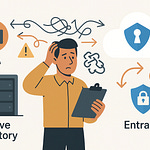Summary
Running Stop Wasting Time — Automate Everything With Syntex is about more than “AI labels your files” — it’s about rethinking how your content lifecycle works. In this episode, I show how Syntex (now folded into SharePoint Premium) brings together document processing, governance, and Copilot readiness under one roof. You’ll get a peek into how Microsoft is turning content from passive blobs into structured knowledge — and the pitfalls admins must avoid along the way.
We’ll walk through the three pillars of the system, real-world wins (like how the London Stock Exchange cut hours of work), licensing traps, and why the Syntex rename isn’t just cosmetic. By the end, you’ll know when automation adds value — and when it risks becoming just another ungoverned layer of chaos.
What You’ll Learn
Why Syntex was folded into SharePoint Premium and what that really means
The three pillars of content AI: classification, metadata extraction, content experiences
How the “brain,” the “muscles,” and the “bouncer” roles work together in Premium
Real-world ROI: how AI reduced workload from hours to minutes in big enterprises
Licensing traps & cost models you need to watch out for
Governance strategies essential to avoid automation causing more mess than it solves
Full Transcript
Here’s the real problem: Microsoft says around two billion new documents get created in Microsoft 365 every day. At that scale, content doesn’t just pile up—it buries teams alive. Most of us spend more time fixing, tagging, or hunting down files than actually using them. That’s the operational drag SharePoint Premium is built to kill.
Instead of another dumping ground, it uses AI models to extract, label, and prep content so Copilot can do something useful with it. We’re going to show you the three pillars, real-world wins, and even the licensing traps. But first—why the rename circus?
The Rebrand Nobody Asked For
Why did Microsoft rename Syntex to SharePoint Premium? It feels like someone in Redmond really does spin a “Wheel of Branding” every quarter. One month it’s Syntex, then you see SAM (SharePoint Advanced Management), and suddenly it’s “Premium.” Cue the confusion: leadership thinks they’re being asked to pay for a whole new product, users think it’s some new app, and admins like us are stuck rewriting docs and answering tickets about why a name has mysteriously vanished from the license list. Here’s the catch though—it’s not just another round of branding chaos for its own sake. This one has an actual architectural reason hiding under the noise.
It’s important to clear up one thing right away: Syntex didn’t disappear. The capabilities—document processing, content assembly, OCR, taxonomy tagging—are still here. They’ve simply been folded into SharePoint Premium, alongside SharePoint Advanced Management, to create a single platform. So instead of juggling separate buckets for AI models, governance policies, and management controls, Microsoft is corralling them under one brand and one technical framework. And here’s the licensing key you’ll want to remember: SharePoint Premium unifies former Syntex services and SharePoint Advanced Management—content processing services remain available pay-as-you-go, and some of the new experiences, like certain content apps, will be seat-licensed. That’s not a rumor; it’s the new model.
Of course, from the admin’s seat, it still creates hassle. We’re the ones explaining for the fifth time why “Syntex” no longer shows up on the purchase history, rebuilding adoption guides, and re-editing governance tables to satisfy compliance checklists. It’s exhausting. But the smarter take is that the naming surface is the least important part here. Microsoft is actually laying down a foundation where AI-driven workflows, Copilot, and governance run through one nervous system instead of scattered organs. The rename is really just a new label slapped on that underlying unification.
So what’s the upside? Think about how the separate parts used to work. You had document classification in one lane, access policy reviews in another, and Copilot trying to connect the dots elsewhere. Each one functioned, but not in sync. SharePoint Premium smashes those silos together and wires them to the same brain. The result: content moves through AI classification, policy compliance, and Copilot prep as one end-to-end workflow instead of a bunch of disjointed tasks prayed over by separate admins. That doesn’t just sound better—it actually performs better.
A real-world case backs it up. In a pilot at the London Stock Exchange Group, around 40 analysts used the platform and saw their document processing workload drop dramatically. What used to take them roughly 15–20 hours per week per analyst was cut to about 60–90 minutes. Nobody in IT is writing that script for fun—those are hours of manual labor erased by AI, OCR, and workflow automation sharing the same platform. For admins, this translates to fewer messes to troubleshoot when tagging goes wrong, far fewer “I can’t find this file” emails from end users, and less firefighting from broken manual processes. That’s tangible.
Here’s the plain English picture: SharePoint Premium isn’t a new app you have to bolt onto your environment; it’s the connective tissue running through Microsoft 365 content. Syntex lives inside it, SAM lives inside it, and Copilot depends on it. Microsoft slapped on a new name, yes, but the motivation wasn’t just rebranding comedy. It’s about making sure the AI brain, the governance immune system, and the workflow muscles all operate off the same set of signals. When you look at it that way, “Premium” is less of a rename and more of the target platform Microsoft wants us all on.
So while the rename jokes never get old—we’ll all keep rolling our eyes at branding roulette—what actually matters is that Premium ties everything together into one system. And it’s that system that’s going to define how your users experience documents day to day. Because at the end of it, your users don’t care what Microsoft calls it; they care about what their files can actually do once they land in SharePoint. And that’s exactly where we need to turn next: not another dumping ground, but documents that can finally work for people instead of weighing them down.
Content Experiences: The Brain of the System
Let’s talk about Content Experiences — the brain at the center of SharePoint Premium. This isn’t about more folders or prettier menus. It’s about wiring intelligence into how users actually deal with files so they don’t drown in clutter or waste half their day searching for the latest contract version.
For years we all played the same game: building folder trees where Finance had “2021 > Invoices > Paid > Processed” while HR stuffed “Policies > Archive > Do Not Delete” into their silo. Naming conventions went rogue, metadata fields were ignored, and you ended up with “final_draft” sitting next to “draft_final.” That whole setup was basically a digital junk drawer. Premium changes that equation by giving us true content experiences that act like the brain—organizing, prioritizing, and feeding context back into the system.
The clearest example is the Business Documents app living right inside Teams. This isn’t theoretical—it’s a real tool Microsoft shipped to give users a single, unified view of critical documents like contracts, statements of work, orders, and invoices. Instead of digging through twelve libraries, they get one pane of glass, complete with alerts for expiring contracts or items needing immediate attention. Even better, it supports content assembly in Word, so users can spin up new contracts from templates without reinventing the wheel. It’s the difference between dealing with chaos and actually getting work done.
Now, think about working outside the firewall. Historically that meant emailing zip files back and forth with vendors, or worse, trying to grant “one-off” access to a random SharePoint folder and praying permissions didn’t break. In Premium, external collaboration gets a grown‑up solution with the Document Portal. You can build branded external sites to share selected docs with suppliers, vendors, or customers—complete with security and identity management baked in. That means cleaner collaboration, less troubleshooting, and a lot fewer calls from partners who “can’t get in.”
Then there’s the new integrated file viewer. This thing isn’t just there to open Word docs—it supports 400+ file types. CAD drawings, PDFs, images, videos…it all works in one consistent viewer. And here’s the real kicker: these files don’t just sit there. You can add annotations, tag colleagues, leave comments, and assign tasks directly on almost anything. Marking up a PDF? Instant. Reviewing a drawing? Call out procurement by name. Multiply that across all supported formats and suddenly users aren’t context‑switching a dozen times a day—they’re just working.
Here’s why we keep calling it the “brain.” It’s filtering the noise, surfacing what really matters, and letting people act on it in context. No more relying on someone to “remember” an expiring contract stashed in Excel; the system highlights it and even pings the right people. Collaboration moves from scattershot file swapping to structured, interactive engagement that actually feeds intelligence back into the platform.
There’s also a direct pay-off for admins. Instead of extending your governance battles into the world of broken folder structures and ignored metadata rules, these content experiences enforce consistency through how they work. The Business Documents app only functions if content is classified. The Document Portal only shares what’s properly tagged. The viewer captures collaboration data directly on the file. All these touchpoints generate the metadata and context Copilot needs—without that, Copilot is just guessing at answers. With it, Copilot can actually deliver useful knowledge instead of junk.
Imagine how different this is from the old “highlight it in yellow and hope someone notices” method. A contract entering the Document Portal gets automatically tagged, surfaced in Teams, monitored for upcoming expirations, and routed with alerts. The lifecycle is visible end‑to‑end without depending on manual policing. That takes the load off users while finally giving IT and compliance a system that doesn’t fight back.
In plain English: SharePoint used to be the world’s most expensive filing cabinet. With Premium, it starts acting like an active brain. It recognizes what files are important, highlights them, makes them interactive, and structures the content to feed downstream tools. Files stop being passive blobs sitting in drives and start functioning like live inputs into processes.
And that’s what sets up the next move. Because brains are only part of the picture. Once content is surfaced, it still needs to be processed into usable data—clean metadata, structured formats, and consistent extraction. Without those muscles pulling the weight, the brain can’t do much at all. And that’s where the real heavy lifting begins.
Content Processing: The Muscles That Do the Work
Now let’s get into the heavy lifters in this story—Content Processing, the actual muscles behind SharePoint Premium. This is where the platform earns its paycheck, because instead of armies of humans tagging files wrong and half-finishing metadata fields, you’ve got AI models doing the slog work consistently, at scale, and without grumbling about overtime.
Think about the way it used to go. Someone in finance slapped “2023” on an invoice, someone else typed “paid,” another left the field blank. OCR ran just well enough to misread numbers like ancient runes. And of course, that critical contract? Buried under mislabeled PDFs until it blew a deadline. Searching wasn’t much better—typing “invoice March” gave you a haystack of irrelevant junk. That wasn’t information management, that was slow-motion chaos.
Premium flips that entire routine. Document processing here isn’t about gimmicks; it’s about core muscle groups: prebuilt or teachable AI models that classify documents, metadata extraction that autofills columns like vendor, total, and due dates, OCR and image tagging that make scans instantly searchable, content assembly for generating new documents, PII detection for compliance flags, redaction tools, and even translation when files don’t arrive in English. That’s a full anatomy of muscle groups pulling in sync.
The net result? A mess of unstructured files becomes structured knowledge in seconds. Instead of fat-fingered metadata and folders hoarded like bad attic boxes, you now have properly tagged, searchable content. And that’s what Copilot and the rest of M365 thrive on—clean, reliable inputs. Humans are great at judgment calls; they’re terrible at labeling a thousand invoices without missing one. Here, the AI is carrying that weight for you.
We’ve already seen proof it pays off. The London Stock Exchange Group ran a pilot with about 40 analysts and cut processing time for 250 documents from around 15 hours down to 60–90 minutes. That wasn’t a rounding error—that was nearly 1,240 days of human effort freed in a single week across the team. Then there’s Microsoft’s own Partner Incentive Operations group, which used Content Assembly to automate letter generation. That one project alone saved them more than 6,000 hours per year. Pair those facts with the reduced risk of errors, and it’s crystal clear: this is serious ROI, not just feature slides.
Admins always worry about model chaos—suddenly you’ve got a zoo of random AI templates running amok. Premium heads that off with the Content Center. You can manage and distribute models from one central hub so your inventory doesn’t sprawl across departments. Start with the prebuilt ones—they’re cheap, easy, and cover most scenarios. Then add custom models when something unique comes up. And here’s a bonus: Microsoft says their prebuilt models aren’t trained on customer data. That reassurance matters when you’re deciding if it’s safe to actually test them on anything sensitive.
Once you let these muscles kick in, the wider system improves immediately. Structured metadata now flows into Power Automate and Power Apps, where you can build dashboards and workflows that no longer need duct tape and prayer. Search starts working like it’s supposed to. Compliance reports don’t send you into the weeds. And your end users finally get content they can trust without manually rebuilding columns every time.
We should pause on the unsung heroes here—metadata extraction and tagging. Nobody loves talking about them, but when they’re automated, they form the backbone of everything else. Clean data feeds workflows. Consistent tagging makes content discoverable. And better structure means Copilot pulls relevant knowledge instead of random guesses. There’s a straight line from automation muscles to smarter AI outcomes downstream.
One caveat to remember: power without control breaks things fast. If you’ve got models classifying hundreds of thousands of files automatically, that’s fantastic—as long as you’ve also got policies watching what happens next. Without checks, all that speed just multiplies mistakes. The strength that clears backlogs can also create oversharing risks, compliance gaps, and lifecycle problems if you don’t guard it.
Which brings us to the next part of the story—because a system this strong still needs something standing at the door, keeping the wrong people out and making sure sensitive data doesn’t end up in the wrong inbox.
Content Governance: The Bouncer at the Door
Every strong system needs more than power—it needs someone at the doors making sure only the right people get through. That’s where Content Governance comes in, the real bouncer keeping SharePoint Premium from turning into the Wild West. Because the truth is, oversharing is the silent killer in every tenant. All it takes is one careless click and suddenly contractors or vendors are strolling through files they were never supposed to see.
We’ve all watched sites multiply like weeds. Every new project spins up a Team, each Team spawns a SharePoint site, and before long you’re drowning in stale libraries, forgotten permissions, and links that went from “anyone in org” to “anyone with link” faster than you can say compliance audit. Nobody sets out to cause a data leak, but sprawl plus human error equals trouble. And let’s be honest—sending around reminders to “be careful” with links works about as well as telling users to “please stop clicking phishing emails.” Gravity doesn’t stop; you plan for it.
If you drop raw automation into this environment without guardrails, the mess just grows legs. AI will gladly speed up mislabeling, push bad files into the spotlight, and spread broken permissions across hundreds of sites. That’s why governance deserves its own pillar in Premium, not just a line item. And here, Microsoft finally gives us the right muscle: Data Access Governance reports, site access reviews, restricted access control, AI-driven policy recommendations, and even Content Event Insights working together to keep content where it belongs.
Start with Data Access Governance (DAG) reports. These shine a spotlight on potential oversharing by flagging which sites are wide open, where sensitivity labels don’t match policies, and when Teams-connected sites have privacy settings out of whack. It’s like turning on floodlights in a basement—you can finally see who actually has access, and whether that makes any sense. Site access reviews take it further, letting IT trigger reviews with content owners so permissions are validated on a regular schedule instead of once a decade. And restricted access control is your hard stop—it locks content so only pre-approved security groups ever touch it, even if someone tries to share wider.
The nightclub analogy works perfectly: DAG is the guest list, access reviews are the ID check, and restricted access control is the velvet rope. Let in the right crowd, bounce out anyone who doesn’t belong. People don’t complain about good bouncers; they know they’re the reason the place doesn’t collapse into chaos.
AI even lends a hand with governance itself. Premium adds AI-driven policy recommendations that match well-governed sites to others across your tenant and suggest fixes to line them up. Instead of admins combing through settings by hand, the system flags where policies should be tightened. On top of that, Copilot shows up directly in the SharePoint admin center. Ask it in plain English: “Show me sites missing classification,” or “Find inactive sites I should archive.” Instead of death-by-PowerShell, you get actionable insights in seconds, and you can actually spend time making calls instead of clicking through endless admin blades.
And here’s a pragmatic angle your finance team will love: Microsoft 365 Archive. Use it to move old Teams and SharePoint sites into cheaper archive storage. Metadata and compliance are preserved, but you’re not burning hot storage and indexing costs on a project from five years ago. Cleaner tenant, lower costs, no compliance risk—it’s the boring but necessary part of governance that keeps the CFO off your back.
Let’s ground this with a scenario. Finance shares a folder with contractors. Hidden inside? Bonus payouts and tax IDs. With legacy SharePoint, you’d only catch that leak during an audit—or worse, in a headline. With Premium, DAG flags it instantly. You run a site access review, restrict permissions, and the problem is fixed before it spreads. The difference isn’t theoretical—it’s cleanup before disaster instead of damage control afterward.
The real balance here is avoiding the extremes. Go light on governance, and your tenant becomes a free-for-all mess. Go too heavy-handed, and users revolt because they can’t do anything without begging IT. SharePoint Premium threads the needle: the governance bouncer does the heavy lifting, but inside the club, users still get to move fast without constant friction. Pair automated classification with access reviews and restricted-access policies, and suddenly automation stops being a risk multiplier and starts being a safety net.
Taken together, this governance pillar closes the loop. Content gets structured, permissions stay sane, and AI has a safe foundation to work from. And that’s the setup for the next big question—because structure alone isn’t the point. The real test is whether all those well-labeled, properly governed files actually make the AI Copilot useful, or if it’s still just a clueless intern making wild guesses.
Why Copilot Finally Becomes Useful
Here’s where the payoff shows up: Copilot finally starts pulling its weight when it has SharePoint Premium feeding it proper context. Microsoft’s own vision example is blunt—imagine typing, “Find all invoices for Fabrikam over ten thousand dollars in 2023 and send copies to finance.” That prompt only works if the invoices are already classified, amounts extracted, and metadata filled in. Without structured content, you’re just asking an AI to rummage through junk drawers and hope it stumbles across the right file.
That’s the gap most tenants have right now. They buy the Copilot licenses, run flashy demos to executives, and expect magic. Instead, the first real query goes off the rails. Ask for vendor contracts expiring this quarter, and Copilot comes back with half a dozen PDFs, someone’s meeting notes, and maybe an email that mentioned “contract renewal.” End users get frustrated, leadership starts side‑eyeing IT, and everyone wonders why the expensive assistant acts like it needs babysitting.
The reason is plain: Copilot isn’t broken—the foundation is. Raw blobs without metadata are unreadable to AI. Premium fixes that by getting invoices labeled with vendor, PO number, amount, and due date. It classifies contracts so expiration dates line up in tags. It OCRs those old PDFs so they’re searchable. Feed that to Copilot and suddenly its answers look useful instead of random.
Think about a manager asking, “Summarize invoices over five thousand dollars from last month and email me a breakdown.” With Premium in play, Copilot doesn’t guess—it pulls those processed invoices, applies the metadata filters, generates a clean summary, and sends it into Teams. That’s not a staged demo—that’s day‑to‑day operations once your tenant actually structures its content. Compare that to a pre‑Premium tenant where Copilot might just shrug and tell you to “check Excel.”
The impact on productivity is real. What used to burn ten minutes of digging and rechecking numbers now takes seconds. Finance managers stop wasting cycles chasing details. Sales leads get snapshots without massaging reports. And IT cuts down on the flood of tickets about why search feels useless. When Copilot is fed through Premium, it goes from hype toy to decision‑making tool.
There’s a practical warning here about how you feed it. Don’t go nuts building fifty hyper‑specific AI classifiers for every weird edge case. That’s how you create model sprawl. The smarter play, pulled right from Microsoft’s own advice, is start with prebuilt models that cover the 80% problems—invoices, receipts, contracts. Those give you immediate wins with minimal setup. Then, only when you’ve proven the value, add custom models for the niches that actually move the needle. Keep it lean, or you’ll just sink your own time and budget.
On the licensing side, remember this: content processing isn’t free. Some services run pay‑as‑you‑go, consuming credits every time you process a file. Others—like certain AI Builder models—require allocating AI Builder credits. If you don’t plan pilots and cost controls up front, finance will ask why your experiment suddenly generated a surprise bill. So test carefully, measure outcomes, and only scale when the business case proves itself.
If you do it right, the transformation is clear. Finance isn’t hand‑keying invoices. Operations isn’t guessing contract expirations. Sales isn’t babysitting spreadsheets. Copilot finally feels less like a random intern and more like part of the team—because the tenant gave it something structured to work with. Premium builds the context, Copilot executes with it, and IT stops being on the hook for defending AI that feels more like smoke and mirrors.
So that’s why the two products are inseparable—you don’t get a smart Copilot without a disciplined SharePoint Premium engine underneath. One builds the structure, the other delivers answers. Together, it stops being a gimmick and starts functioning like the system Microsoft keeps promising.
And now that we’ve seen how the AI gets useful, the last thing to sort out is the toughest one for admins: what this all costs, and how to pay for it without ending up in licensing limbo.
Conclusion
SharePoint Premium isn’t just a shiny rebrand—it’s the nervous system wiring the messy parts of Microsoft 365 into something coherent. Weak, untagged content sitting in digital junk drawers now gets processed, classified, and governed into knowledge your org can actually use. It’s muscle, brain, and bouncer working together instead of duct-taped hacks. And thousands of Syntex customers have already made the move into this Premium experience.
If you’re wondering where to start, keep it simple: pick one high-value case like invoice processing, run a small Content Center pilot with prebuilt models, then layer on DAG reports and site access reviews before scaling out.
Subscribe at m365.show or follow M365.Show Linkedin Page for livestreams with MVPs who’ve broken this stuff and fixed it.











